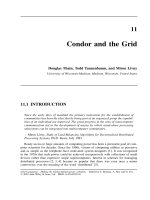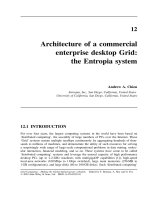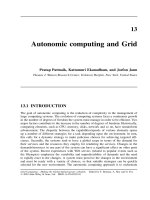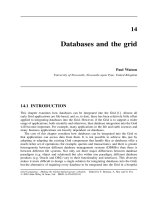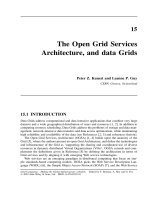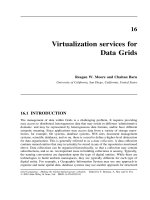Tài liệu Grid Computing Infrastructure docx
Bạn đang xem bản rút gọn của tài liệu. Xem và tải ngay bản đầy đủ của tài liệu tại đây (728.01 KB, 48 trang )
Grid Computing
Infrastructure
Nguyen Quang Huy
Senior Technical Sales Consultant
Agenda
y Business Challenges
y Solution - How Can Oracle Help?
y Benefits
y Market Momentum & Proof Points
y Summary
Agenda
y Business Challenges
y Solution - How Can Oracle Help?
y Benefits
y Market Momentum & Proof Points
y Summary
The Four Fundamental Goals of I.T.
y Better Information
y Better Processes
y Better Quality of Service
y Lower Cost
…Balancing The Goals Is Complex
Business
Processes
Business
Information
Quality of
Service
Cost
Problem: Islands of Computation
Financials
Financials
Procurement
Procurement
Service
Service
Supply
Supply
Chain
Chain
Files
Files
Sales
Sales
HR
HR
y Expensive, underutilized components
y Limited reliability
y Fragmented management
y Slow to adjust to business needs
Print Invoices
Generate POs
Credit
Verification 1
User
Authentication 1
Account
Validation 1
Create
Customers
Credit
Verification 2
User
Authentication 2
Account
Validation 2
y Hard to adapt to
changing business
requirements
y Duplication of
functionality means
wasted resources
y Small fixes require large
investments of time and
labor
Inflexible, Inefficient, Hard to Maintain
Problem: Monolithic Applications
Problem: Complex Infrastructure
Screen
Scrape
Screen
Scrape
Screen
Scrape
Screen
Scrape
Message
Queue
Message
Queue
Message
Queue
Download
File
Download
File
Download
File
Transaction
File
Transaction
File
Transaction
File
ORB
ORB
CICS Gateway
CICS Gateway
APPC
APPC
RPC
RPC
Transaction
File
Sockets
Sockets
Message
Message
Application
Application
Application
Application
Application
Application
Application
Application
Application
Application
Costly, Inflexible and Incompatible
79% of Budget Spent on Maintaining Existing
Systems
Which Is Very Expensive To Manage…
Source: Gartner 2004
Information Technology Evolution
Mainframe
Mainframe
Computing
Computing
Client
Client
-
-
Server
Server
Computing
Computing
Internet
Internet
Computing
Computing
Grid
Grid
Computing
Computing
Host Computers
Host Computers
Tape Storage
Tape Storage
Legacy Databases
Legacy Databases
Host Architecture
Host Architecture
No Bus. Processes
No Bus. Processes
SMP, MPP
SMP, MPP
DAS Disks
DAS Disks
Relational DBMS
Relational DBMS
C/S Architecture
C/S Architecture
ERP Processes
ERP Processes
Rack Mounted CPUs
Rack Mounted CPUs
Storage Arrays
Storage Arrays
Clustered DBMS
Clustered DBMS
3 Tier Architecture
3 Tier Architecture
Enterprise Processes
Enterprise Processes
Blade Servers
Blade Servers
Low Cost SAN, NAS
Low Cost SAN, NAS
Grid
Grid
-
-
Enabled DBMS
Enabled DBMS
Service Oriented Arch.
Service Oriented Arch.
Composite Processes
Composite Processes
Grid Computing
y Expensive Processors
y Expensive Storage
y Idle Excess Capacity
y Single Points of Failure
y Add Capacity in Large Units
y $20,000 per GHz
y Cheap Processors
y Cheap Storage
y No Excess Capacity
y Fault tolerant
y Add Capacity Modularly
y $860 per GHz (30X cheaper)
Islands of Computing
Grid Computing
Service Oriented Architecture
Service Oriented Architecture is an
Application Architecture that is designed to
achieve loose coupling among interacting
software applications. SOA provides greater
flexibility in developing, integrating, and
managing Enterprise Applications.
Application Platform Suites
An Application Platform Suite (APS) is an
integrated Infrastructure for Enterprise
Applications consisting of an Application
Server, Integration Server, Portal Server,
and other components. APSs lower the cost
of ownership of Enterprise Applications.
ROI & TCO
Adaptable Infrastructure
Reactive Managed Agile
Low ROI
High ROI
Low TCO
Utility Computing
Many servers
Reduce Servers
Reduce Datacenters
Database Consolidation
Application Access Consolidation
9 Reduce Hardware
9 Simplify Management
9 Increase Service Levels
9 Higher Availability
Application technology Consolidation
Technology Consolidation
Automate
Consolidate
Standardize
“The typical enterprise, with mainframe,Unix and Windows
deployments, could save between 8.5% & 10.5% of the data
center budget by implementing standardization, automation and
consolidation.”
Gartner Research
July 2003
Next Steps for IT…
Agenda
y Business Challenges
y Solution - How Can Oracle Help?
y Benefits
y Market Momentum & Proof Points
y Summary
Consolidation:
Why Doesn’t Everyone Just Do It ?
Cons
y High Risk
y High Cost
Pros
y Better
Information
y Better
Processes
9
X
Consolidated
Information
Database
Blade
Blade
Blade
Blade
Blade
Blade
Blade
App 1
App 2
App 5
App 3
App 4
App Server &
The Platform
O/S
O/S
O/S
O/S
O/S
O/S
O/S
Consolidation:
Oracle Architecture
Industry-standard,
low-cost h/w & o/s
• Limitless capacity
• Constant availability
• Pay less, get more
Consolidation:
Highest Performance at Low Cost
0
200,000
400,000
600,000
800,000
1,000,000
1,200,000
1x64 16x4
TPM-C
1,008,144
1,008,144
1,184,893
1,184,893
$8.33 /tpmC
$8.33 /tpmC
$5.52 /tpmC
$5.52 /tpmC
Same 1.5 GHz Itanium2 CPUs
Source: TPC, as of January 1, 2004: Oracle Database 10g with Real Application Clusters, 16 nodes of 4-way HP Integrity rx5670, 1,184,893 tpmC, $5.52/tpmC,
available 4/30/2004. Oracle Database 10g on 64-way HP Integrity Superdome, 1,008,144 tpmC, $8.33/tpmC, available 4/14/2004.




